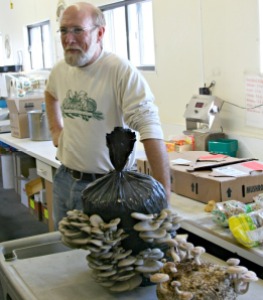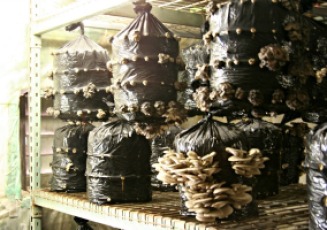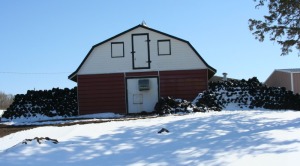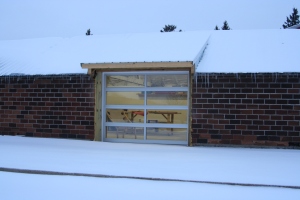 In 1985, two years before Steve purchased our 80 acres from the Sisters of the Order of Saint Benedict, Kevin Doyle, who was a classmate of Steve’s at St. John’s University, purchased the monks’ old hog farm in Collegeville.
In 1985, two years before Steve purchased our 80 acres from the Sisters of the Order of Saint Benedict, Kevin Doyle, who was a classmate of Steve’s at St. John’s University, purchased the monks’ old hog farm in Collegeville.
These twin hog farms had been owned by the monastery and abbey (at a safe distance to keep the smell and waste away) and run by resident farmers who raised their families on the land and provided ample pork for the monastic communities and their colleges. However, both stopped farming long before the properties were sold.
When Kevin Doyle bought his land, he had a strong business plan. He had been living in the Twin Cities and a friend in business school asked him if he had an idea for a business they could use for a class project. Kevin had seen a report on a desk that outlined the various kinds of mushrooms you could grow in the United States. It surprised him, because the only kind you could get in the grocery store were white button mushrooms.
 In the next months, he researched mushroom growing and also found out there wasn’t another mushroom grower in Minnesota. Shitake and oyster mushrooms seemed the easiest to grow, but in order to offer his customers what they’d want, he also went into the business of buying other kinds of mushrooms from other sources. No grocery or restaurant wants to go to five or six different vendors for different varieties of mushrooms. And soon enough, everyone was enjoying different kinds of mushrooms!
In the next months, he researched mushroom growing and also found out there wasn’t another mushroom grower in Minnesota. Shitake and oyster mushrooms seemed the easiest to grow, but in order to offer his customers what they’d want, he also went into the business of buying other kinds of mushrooms from other sources. No grocery or restaurant wants to go to five or six different vendors for different varieties of mushrooms. And soon enough, everyone was enjoying different kinds of mushrooms!
These days, Forest Mushrooms in Collegeville is a booming business. They provide 18 kinds of mushrooms (and probably more if they get a specialty request), to food service providers, groceries and other large buyers. Kevin Doyle spends most of his time buying and selling mushrooms, not so much tending to the mushrooms sprouting out of plastic bags in the old farrowing barn.
Mushrooms grow fast. Kevin has eight employees: a full-time driver for deliveries, a couple business people, and four who tend to the oysters and shitakes. They sell something like 2,500 lbs of oyster and 1,500 lbs of shitake a week (I might not be remembering these numbers right, but their close– basically, tons of mushrooms!) They now outsource the preparation of the growth material: sawdust and grain blocks for the shitake and bags of straw for the oysters. They still have to steam, soak and otherwise prep them once they arrive, and then they go onto racks in the dark, humidity-controlled barns. In five days, they’re ready to harvest. (The sawdust blocks can be used four times, the bags only once.)
I went out there on Tuesday with a group from the college, as part of Earth Day/Sustainability week. I mostly wanted to get inside and see the tile barn that is exactly like ours. Kevin said that when he bought the place, all the other buildings had been moved or taken apart. In fact, someone had even gone through and stolen the steel posts out of the current barn.
When this barn was built, in 1938, the monks laid heated pipe in the floor. He said there was some animosity among the local farmers when they showed off their “state of the art” facility.
This was 1938, after all. The locals didn’t have heated floors for their sows.
Our farm is so different from this one, which has lots of industrial buildings like our machine shed and one house. And Kevin Doyle doesn’t get many days off or take many vacations. The mushrooms are as demanding as cows, and negotiating and sourcing fresh food is quite complicated.
Our farm started more as an idea– some Oblates living close to the monastery and living simply, bringing back the prairie and holding some things in common. Over timethe farrowing barn has housed Coco the horse, machinery, storage, some chickens, and now the furniture shop.
It was briefly a social space after Paul took out the feeding troughs and before Steve raised the roof and installed the glass door.
What goes on in our old tile farrowing barn is more refined than the mushrooms, but less lucrative. What I love, though, is that these buildings are still there and still humming along.







Love this on so many levels. Finding your niche and living in it, Taking something that has lived out its original purpose and remaking it into something new, Giving to the community not only remembrance of the past, but new industry as well. Think we, in our own lives, need to be as flexible as your hog farms.
Hi Susan! I hadn’t seen or known about this piece until I just decided to google “oyster mushrooms in Minnesota” today and happened to see this! Thanks for the kind words and yes, it is quite accurate. I love seeing that you are preserving and utilizing your old barns as well! Kevin Doyle
Hi Kevin! Thanks for reading it. It is good that the two monastic hog farms still have a presence!